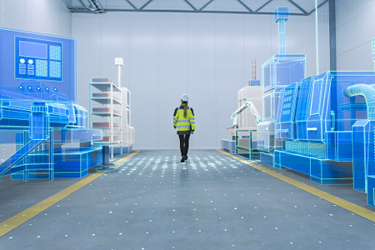WWEMA Window: 3-D Imagery As A Workforce Recruitment Tool
By Jon Forrest

Maintaining proper functioning in water and wastewater industry systems requires highly automated, cutting-edge technology. The continually changing system dynamics require implementing the latest available technology to maintain a high level of water quality leaving drinking water and wastewater plants. The engineering process is comparable to other industries such as chemical and power generation in the number of instruments, control loops, electric actuators, and pumps needed. Whether you are talking about drinking water, wastewater, desalination, or water transportation, the same level of technology applies to all phases.
It takes more than 380,000 highly skilled water and wastewater personnel to ensure the public supply of safe drinking water and to protect our lakes, streams, and groundwater. Advancements in water treatment and supply technology have increased the skill level and training required of this workforce. Over the next decade, the water sector is expected to lose between 30 to 50 percent of the workforce to retirement. According to the National Rural Water Association, many of these employees have worked at the same utility for the majority of their careers, and they will depart with decades of valuable institutional knowledge.
Therein lies the challenge. Why does our industry not seem to attract both a large number and highly skilled new talent like other industries such as wind, solar power, or battery vehicles do? Our industry needs this next generation to continue the important and increasingly complex work that we do. What is more basic and important than helping to produce and maintain clean water that is essential for life and commerce? I contend that as an industry we must do everything possible to sell ourselves and the important mission we fulfill, and what better way to do this than to wave the technology flag?
A 3D graphic representation of water systems can be that flag.
When a potential hire is reviewing the water plant and treatment systems, if they walk into the operator’s room and see a 3D graphic representation of the plant on the computer screen, it immediately conveys that this plant is high tech, with state-of-the-art systems. Seeing the entire plant and all the technology it takes to produce clean water will certainly make the water and wastewater industry seem more appealing as a career path.
Great news — your interviewee has decided to join your team. Now, in the next phase, these same detailed 3D graphics that helped them make the decision to work there will now help them to optimize the learning curve. Part of the orientation process can be self-guided time going through the plant with SCADA graphics (just be sure they are logged in as a ‘view-only’ operator). Given the graphics they just reviewed so closely represent the actual systems, pumps, valves, and actuators, you have already started the education process before they leave the operator’s room. Further, this new generation is accustomed to working with technology and their familiarity will aid them in quickly relating what they see on computer dashboards to actual physical parts and how to operate and maintain them.
These same graphics and system trends will also help tremendously to optimize the treatment processes, as technology becomes more integral to plant operations. We have seen operators consistently use these graphics to view system interactions that are not always apparent from a simple on/off, green/red representation of plant systems. The data or perhaps more appropriately the intelligence that can be extracted from these graphics have allowed systems to save tens of thousands of dollars with reduced chemical costs and energy costs. None of this would be possible without the understanding of system interactions that comes from these enhanced platforms.
The enhanced graphics can provide a link to a specific standard operating procedure (SOP) that itemizes detailed descriptions and actions that remind the operators of the required procedures for manual operation in the event of a control system failure. This same type of link can provide a path to the associated equipment with a detailed and refined view for the maintenance team that provides them with direction.
These same enhanced graphics, especially with small- and medium-size systems, will be an incredibly helpful tool for the local City Councils, County Commissioners, or local boards of directors to understand the water systems. The visual representation of the systems shows the interaction of all the different pieces of the water filtration/treatment process and helps convey the need to have the latest technology for clean and efficient operation. All too often the sentiment will be ‘Why do we need to spend money if the equipment and systems are not broken’. This school of thought will eventually spell disaster for a system. We have all seen the national news showing terrible examples, and the resulting negative public perception can cause serious social and economic impacts on a community.
The best part of this entire process of enhanced graphics comes after the employee leaves the plant. You have not only gained a talented and loyal employee who is working hard to improve the water quality leaving the plant, but that employee will also be more likely to tell their friends what an important industry they are in, enticing others to follow the same path.
All of this from some enhanced 3D graphics. Wave that flag!
Jon Forrest is President of FORTECH, Inc., which is headquartered in Charlotte, NC. Forrest serves on WWEMA’s Board of Directors and Marketing & Member Services Committee. WWEMA is a non-profit trade association that has been working for water and wastewater technology and service providers since 1908. WWEMA’s members supply the most sophisticated leading-edge technologies and services, offering solutions to every water-related environmental problem and need facing today’s society. For more information about WWEMA, visit www.wwema.org.
